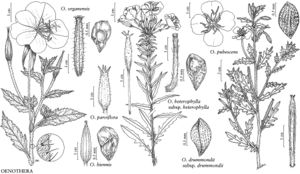Difference between revisions of "Oenothera pubescens"
Syst. Veg. 2: 229. 1825.
imported>Volume Importer |
imported>Volume Importer |
||
| Line 79: | Line 79: | ||
|publication year=1825 | |publication year=1825 | ||
|special status= | |special status= | ||
| − | |source xml=https://xjsachs2@bitbucket.org/aafc-mbb/fna-data-curation.git/src/ | + | |source xml=https://xjsachs2@bitbucket.org/aafc-mbb/fna-data-curation.git/src/e39f0e846f172941159b2045254d62d10d9823f6/coarse_grained_fna_xml/V10/V10_173.xml |
|subfamily=Onagraceae subfam. Onagroideae | |subfamily=Onagraceae subfam. Onagroideae | ||
|tribe=Onagraceae tribe Onagreae | |tribe=Onagraceae tribe Onagreae | ||
Latest revision as of 10:31, 9 May 2022
Herbs annual or biennial, densely to sparsely strigillose, sometimes also villous and glandular puberulent distally; from a taproot. Stems unbranched or with branched central stem and ascending to decumbent lateral branches arising from rosette, 5–50(–80) cm. Leaves in a basal rosette and cauline, basal 5–14 × 0.5–2.5 cm, cauline 2–8 × 0.5–2.5 cm; blade narrowly oblanceolate to narrowly elliptic or narrowly oblong, margins usually dentate to deeply lobed; bracts spreading, flat. Flowers usually 1 opening per day near sunset; buds with free tips erect, 0.1–1 mm; floral tube erect, becoming recurved and nodding, then erect again just before anthesis, 15–50 mm; sepals 5–25 mm; petals yellow, fading reddish orange, broadly obovate to obcordate, 5–25(–35) mm; filaments 6–18 mm, anthers (2–)3–9 mm, pollen ca. 50% fertile; style 20–60 mm, stigma surrounded by or slightly exserted beyond anthers at anthesis. Capsules cylindrical, sometimes slightly enlarged distally, 20–45 ×2–4 mm. Seeds brown, sometimes dark-flecked, 0.9–1.5 × 0.6–1 mm. 2n = 14.
Phenology: Flowering (Feb–)Apr–Sep(–Oct).
Habitat: Open sites in montane habitats.
Elevation: (1300–)1500–2500(–3100) m.
Distribution
Ariz., N.Mex., Tex., Mexico, West Indies, Central America (Guatemala), South America (Colombia, Ecuador, Peru).
Discussion
Oenothera pubescens is a PTH species and forms a ring of 14 chromosomes in meiosis, and is self-compatible and autogamous (W. Dietrich and W. L. Wagner 1988).
Oenothera pubescens has been collected once in California in 1884 (Newberry Springs, San Bernardino County), where it was temporarily introduced or a natural occurrence that was extirpated. Collections from west Texas (Brewster, Jeff Davis, and Presidio counties) have been made since 1990 and a few others collected earlier were misidentified as O. laciniata.
Selected References
None.
